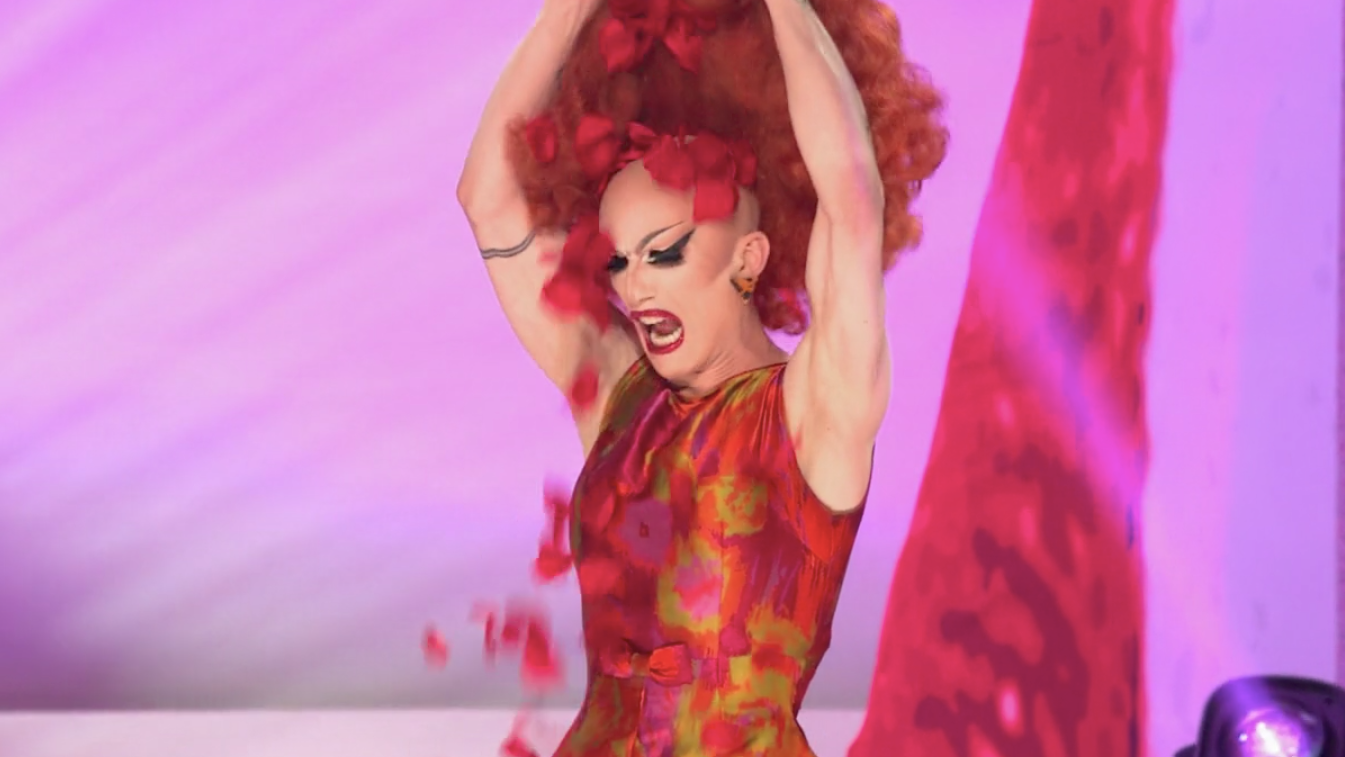How to predict who will win Rupaul's drag race

When you’re about to predict the drag race
I entered this competition to predict the outcomes of RuPaul’s Drag Race season 11 - it was really fun and I learned a lot, so I thought I’d write down how the model I made works.
Model
My model treats the outcomes of both Drag Race episodes and Data For Progress’s surveys as depending probabilistically on the abilities of the contestants. The higher a queen’s ability, the more likely it is that she will do well. Other factors - e.g. does Ru just want to keep you around for the drama? - don’t directly feature, but can be thought of either as implicitly part of ability or as contributing a bit of randomness.
Priors
Although there there are at least four dimensions of drag ability, for simplicity I assumed that these can safely be reduced to one number (\eta_i) for each contestant (i).
I used a pretty standard multilevel structure to represent the available pre-competition information about these ability parameters:
$$
\begin{align*}
\eta_i &\sim Normal(X_i\beta, \sigma_{\eta}) \
\beta &\sim Normal(0,1) \
\sigma_{\eta} &\sim halfNormal(0, 1)
\end{align*}
$$
These assumptions allow us to use some information in a design matrix $X$ to predict how good each competitor will be, with the amounts being controlled by the $\beta$ parameters, and deviation from the predicted ability controlled by the parameter (\sigma_{\eta}).
To fill up the design matrix I used age and number of pre-competition twitter followers. I massaged the latter numbers a little: instead of using the raw numbers I used each contestant’s rank compared to the other season starters. This was to avoid being biased by between-season trends in the number of followers drag race competitors tend to have.
Episode outcomes
The trickiest bit was to connect abilities with episode outcomes, which don’t fit that neatly into a standard statistical model (at least not one that I was aware of before working on this competiton).
Each episode ends with the remaining contestants being sorted into ordered groups - typically these are win, high, safe, low, bottom and eliminated - according to how well they performed. The total number of contestants changes from week to week, and the number in each group is unpredictable - Ru often mixes things up with double wins, double eliminations and suchlike.
To represent this structure in my model I started with the rank-ordered logit model. This is a standard-ish model for data where some things are ranked in a way that depends probabilistically on their latent qualities. [[http://khakieconomics.github.io/2018/12/27/Ranked-random-coefficients-logit.html][This blog]] has a really nice explanation of the rank-ordered logit model and an interesting case study from economics.
The main idea with a rank-logit model is that the probability that option (i) comes first out of (J) options is
$$ \frac{\exp(\eta_i)}{\sum_{j=i}^{J}\exp(\eta_j)} $$
The probability of a whole ranking (e.g. (a) beats (b) beats (c) beats (d)) can be found by evaluating this equation for each number from (1) to (J-1), then multiplying together the resulting probabilities.
This would fit the drag race if only Ru would explicitly rank every queen in every episode, with no ties allowed. To capture what actually happens - i.e. multiple competitors getting the same rank - the rank ordered logit model needs to be generalised a bit.
The correct generalisation finds the probability of an outcome with ties by enumerating all the possible no-tie orderings that are consistent with it and averaging their probabilities. This paper lays out the maths of this idea. I had a go at applying this approach to drag race outcomes but didn’t get very far because there are just too many no-tie orderings to consider. Say there is one winner, two high queens, 9 safe contestants, one low queen and two eliminees: this not-too-unusual early season outcome has (* 9! * 2! = 1451520) compatible no-tie orderings.
Instead of the correct solution, I used the following approximation. For each rank, I found the rank-logit probability that each non-eliminated queen with that rank would came first in a contest featuring them and all the queens with equal or worse rank. In other words, I found this number for each non-eliminated queen:
$$ \frac{\exp(\eta_i)}{\sum_{rank(j)\geq rank(i)}^{J}\exp(\eta_j)} $$
To find the probability of a whole episode’s outcome I multiplied all of these numbers together.
I’m still not sure this is the best way to approximate a full rank-ordered logit model with ties, but I was a bit encouraged when I found [[http://www.glicko.net/research/multicompetitor.pdf][this paper]] by Mark Glickman and Jonathan Hennessy. The authors use the same approximation with some success to model competitive downhill skiing, which it turns out is structurally kind of similar to the drag race! They also explain the model very nicely - check it out!
Viewer survey data
Even if the model extracted as much information as possible from the outcome data, there would still be some room for improvement, as the final result doesn’t always tell the whole story. Some wins are more impressive than others, and sometimes even a winning performance can reveal long-term limitations. To try and capture this kind of dynamic I thought the survey results on data for progress’s spreadsheet might be a nice complement to the outcome data. Whereas the outcomes are nice because they are the exact same thing the model wants to predict, the survey responses are also nice because they use extra information that isn’t available in the outcomes.
The survey data consists of binary choices between two current contestants - the answerer has to enter a winner and a loser, and the time they took to make the choice is recorded. I decided to only use data from the most recent available survey out of fear that old ones might mess things up. I found the aggregate win/loss score for each pair and modelled these as depending on the same abilities as the episode outcome data, according to the following equation:
$$ wins_{ij} \sim Binomial(comparisons_{ij}, logit^{-1}(\eta_i -\eta_j)) $$
Putting the same \eta variables in two different likelihood functions is a really simple example of joint modelling, which you can find out more about in [[https://www.sambrilleman.com/talk/2018_contributed_stancon/][this video]].
Implementation
I largely followed [Shira Mitchell’s approach](https://shiraamitchell.github.io/rpdr#model] to representing drag race outcomes in Stan - the ability parameters for the contestants in each episode are sorted according to the outcome, making it much easier to calculate all the (log scale) probabilities. Here’s how I implemented the custom likelihood function described above:
functions {
real rpdr_outcome_lp(vector ability, int[] episode_rank){
real out = 0;
int first_in_group = 1;
for (contestant in 1:rows(ability)){
if ((contestant > 1)
&& (episode_rank[contestant] > episode_rank[contestant-1])){
first_in_group = contestant;
}
if (episode_rank[contestant] < max(episode_rank)){
out += ability[contestant] - log_sum_exp(ability[first_in_group:]);
}
}
return out;
}
}
Here’s the rest of the model:
data {
int<lower=1> N; // Number of episode participations
int<lower=1> K; // Number of predictors
int<lower=1> E; // Number of episodes
int<lower=1> C; // Number of contestants
int<lower=1> N_survey; // Number of surveys
matrix[C, K] X; // Contestant level predictors
// episode data
int<lower=1> N_episode_contestant[E];
int<lower=1,upper=6> episode_rank[N];
int<lower=1,upper=C> contestant[N];
// survey data
int<lower=1,upper=C> survey_contestant[N_survey];
int<lower=1,upper=C> survey_opponent[N_survey];
int<lower=1> survey_count[N_survey];
int<lower=0> survey_wins[N_survey];
// config
int<lower=0,upper=1> use_survey;
int<lower=0,upper=1> use_episodes;
}
parameters {
vector[C] ability_z;
real<lower=0> sigma_ability;
vector[K] beta;
}
transformed parameters {
vector[C] ability = X * beta + ability_z * sigma_ability;
}
model {
int pos = 1;
// priors
ability_z ~ normal(0, 1);
beta ~ normal(0, 1);
sigma_ability ~ normal(0, 1);
// likelihood
if (use_survey == 1){
survey_wins ~ binomial_logit(survey_count, ability[survey_contestant] - ability[survey_opponent]);
}
if (use_episodes == 1){
for (e in 1:E){
int contestants[N_episode_contestant[e]] = segment(contestant, pos, N_episode_contestant[e]);
int episode_ranks[N_episode_contestant[e]] = segment(episode_rank, pos, N_episode_contestant[e]);
target += rpdr_outcome_lp(ability[contestants], episode_ranks);
pos += N_episode_contestant[e];
}
}
}
I used pandas, pystan and arviz to get data in and out of the resulting model. Here’s a link to a github repository with all the code.
Results
Here’s what the model thinks of the remaining season 11 competitors (the low and high are the 10% and 90% quantiles of the posterior distributions). I didn’t include survey data this week as it was a bit out of date.
ability_low ability_median ability_high
contestant_name
Brooke Lynn Hytes -0.04 0.22 0.59
Yvie Oddly -0.12 0.13 0.48
Silky Nutmeg Ganache -0.12 0.12 0.44
A'keria Chanel Davenport -0.11 0.11 0.42
Vanessa Vanjie Mateo -0.17 0.09 0.35
These results more or less agree with my take on the current situation. Brooke is the clear frontrunner, with very little to choose between the remaining four and Vanjie probably the weakest.
I’ve also been sanity checking the model by looking at who it thinks were the best RPDR contestants of all time. This is a bit tricky as there aren’t any between-season comparisons.
ability_low ability_median ability_high
contestant_name
Sasha Velour -0.00 0.28 0.65
Jinkx Monsoon -0.01 0.27 0.65
Tyra Sanchez -0.01 0.27 0.66
Bianca Del Rio -0.05 0.26 0.67
Sharon Needles -0.05 0.24 0.63
Brooke Lynn Hytes -0.04 0.22 0.59
Ginger Minj -0.04 0.21 0.53
Shea Couleé -0.05 0.21 0.54
Violet Chachki -0.07 0.19 0.53
Manila Luzon -0.05 0.18 0.52
Raja -0.07 0.18 0.53
Bob the Drag Queen -0.07 0.18 0.51
Aquaria -0.08 0.17 0.50
Roxxxy Andrews -0.08 0.17 0.49
Alaska -0.08 0.15 0.47
Chad Michaels -0.13 0.14 0.51
Kim Chi -0.12 0.13 0.47
Yvie Oddly -0.12 0.13 0.48
Nina Flowers -0.12 0.13 0.51
Trinity Taylor -0.11 0.13 0.44
This seems more or less plausible - as Yvie Oddly observed this season, Sasha Velour had talent!

When your predictions recognise that your fave is the best
Things that could be improved
This was a really fun task - I learned lots about ordinal models and came up with something that more or less passed my smell test. There are a few extra features it would be nice to add - I’m not sure I’ll ever get round to them but it’s still a good exercise.
Probabilistic predictions
Rather than just ranking competitors by ability it would be nice if the model outputted the probability of each queen winning or being eliminated in each episode. This wasn’t strictly required for this competition as only a discrete best/worst prediction for the next episode was needed, but would make it a lot easier to test the model. Unfortunately a custom random number generating Stan function would be needed for this and I didn’t quite have the emotional energy to attempt to implement one.
Extra ability dimensions
There were a few times when I thought the model was a bit limited by only having one ability dimensions. For example, in the snatch game episode I thought it was pretty clear that personality queens Nina West and Silky Nutmeg Ganashe would do better than indicated by their overall track records.
Separate lipsync mechanics
I think it would be nice to handle lipsyncs with a separate model. I initially took this approach but gave up as I seemed to be doing everything twice and the lipsync component of the model wasn’t having a very big effect. Of course, as soon as I did this Rajah emerged as season 11’s lipsync assassin and I started getting second thoughts.